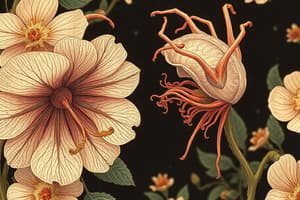Podcast
Questions and Answers
What is the main difference between sexual and asexual reproduction?
What is the main difference between sexual and asexual reproduction?
- Sexual reproduction produces genetically identical offspring, while asexual reproduction involves meiosis and produces genetically diverse offspring.
- Asexual reproduction results in the union of gametes, while sexual reproduction does not involve gamete fusion.
- Sexual reproduction occurs in plants, while asexual reproduction occurs in mammals.
- Sexual reproduction involves meiosis and produces genetically diverse offspring, while asexual reproduction does not involve meiosis and produces genetically identical offspring. (correct)
Which of the following structures are specific to male mammals for sexual reproduction?
Which of the following structures are specific to male mammals for sexual reproduction?
- Pollen-producing flowers
- Seminal vesicles (correct)
- Fallopian tubes
- Ovaries
What is the purpose of internal fertilization?
What is the purpose of internal fertilization?
- To synchronize with seasonal changes
- To increase the likelihood of finding suitable partners
- To expose gametes to harsh external environments
- To ensure privacy for sensitive gametes (correct)
Which strategy of asexual reproduction involves the regeneration of an entire organism from a fragment?
Which strategy of asexual reproduction involves the regeneration of an entire organism from a fragment?
How do organisms benefit from continuous reproduction cycles?
How do organisms benefit from continuous reproduction cycles?
In plants, what structure hosts ovules that later develop into seeds upon pollination?
In plants, what structure hosts ovules that later develop into seeds upon pollination?
What is the main difference between sexual and asexual reproduction?
What is the main difference between sexual and asexual reproduction?
During sexual reproduction, what is the significance of meiosis in the process?
During sexual reproduction, what is the significance of meiosis in the process?
In sexual reproduction, where does fertilization usually take place?
In sexual reproduction, where does fertilization usually take place?
What is the role of germ cells in sexual reproduction?
What is the role of germ cells in sexual reproduction?
What is the primary function of ova and semen in sexual reproduction?
What is the primary function of ova and semen in sexual reproduction?
How does asexual reproduction contribute to genetic variation within species?
How does asexual reproduction contribute to genetic variation within species?
Study Notes
Reproduction: Exploring Sexual and Asexual Methods
Reproduction is a fundamental process by which living organisms create new individuals like themselves through biological means. Two primary forms of reproduction exist—sexual, where offspring result from the fusion of gametes produced between two parents with distinct genetic material, and asexual, wherein one parent generates genetically identical offspring without fusing gametes. Let's delve into these methods and investigate their key features.
Sexual Reproduction
Sexual reproduction occurs when eggs, or ova, from females unite with sperm, or semen, from males, resulting in the formation of a zygote containing unique DNA derived from both parents. This method increases genetic variation within species, bolstering evolution and survival. In most animals, including humans, this process involves several stages:
- Replication: Cells divide and form gamete precursors called germ cells, which produce either spermatocytes (male) or oogonia (female).
- Meiosis: Germ cells undergo meiotic division, creating haploid gametes, such as sperm or eggs, each having half the number of chromosomes found in somatic cells.
- Fertilization: Gametes combine during sexual intercourse (external fertilization), or after reaching the female's body via various mechanisms (internal fertilization), forming a diploid zygote.
The overall process results in a new generation possessing a mixture of genes from both parents, thereby enhancing its ability to adapt to changing environmental conditions.
Reproductive Organs
Species have distinct sets of structures designed specifically for sexual reproduction, allowing them to accomplish successful fertilization. For example, male mammals have testes producing sperm, while females develop ovaries producing eggs, along with accompanying accessory organs such as seminal vesicles and Fallopian tubes in mammals. Plants also exhibit specialized reproductive tissues–male plants bear pollen-producing flowers, whereas female plants host ovules, later developing into seeds upon pollination.
Asexual Reproduction
Asexual reproduction differs from sexual because it does not involve meiosis and produces genetically identical offspring, known as clones. Multiple strategies occur across diverse kingdoms; some common examples include budding, fragmentation, and parthenogenesis. While asexual reproduction diminishes population genetic variability relative to sexual reproduction, it has advantages in rapid colonization, resource efficiency, and maintaining species integrity.
Fertilization
Fertilization refers to the union of gametes, resulting in the creation of a single cell capable of further development into a multicellular organism. Internal fertilizers deposit sperm inside the female's reproductive tract before reaching the egg, ensuring privacy for the sensitive gametes. External fertilizers release gametes directly into water or air, increasing the likelihood of finding suitable partners, albeit exposing the fragile sperm and eggs to harsh external environments.
Reproductive Cycles
Many organisms follow specific reproductive patterns or cycles throughout the year, referred to collectively as breeding seasons or mating periods. These cycles may synchronize with seasonal changes affecting food availability, temperature, day length, or other ecological factors. Some organisms reproduce continuously, enabling flexibility in responding to variations in resources and conditions.
By understanding these core concepts and processes involved in reproduction, we can appreciate the intricate ways life maintains continuity over generations, allowing us to better comprehend our own existence and those around us in nature.
Studying That Suits You
Use AI to generate personalized quizzes and flashcards to suit your learning preferences.
Description
Delve into the world of reproduction by exploring sexual and asexual methods used by living organisms to create new individuals. Learn about the processes of sexual reproduction, reproductive organs, asexual reproduction, fertilization, and reproductive cycles to understand how life maintains continuity over generations.




